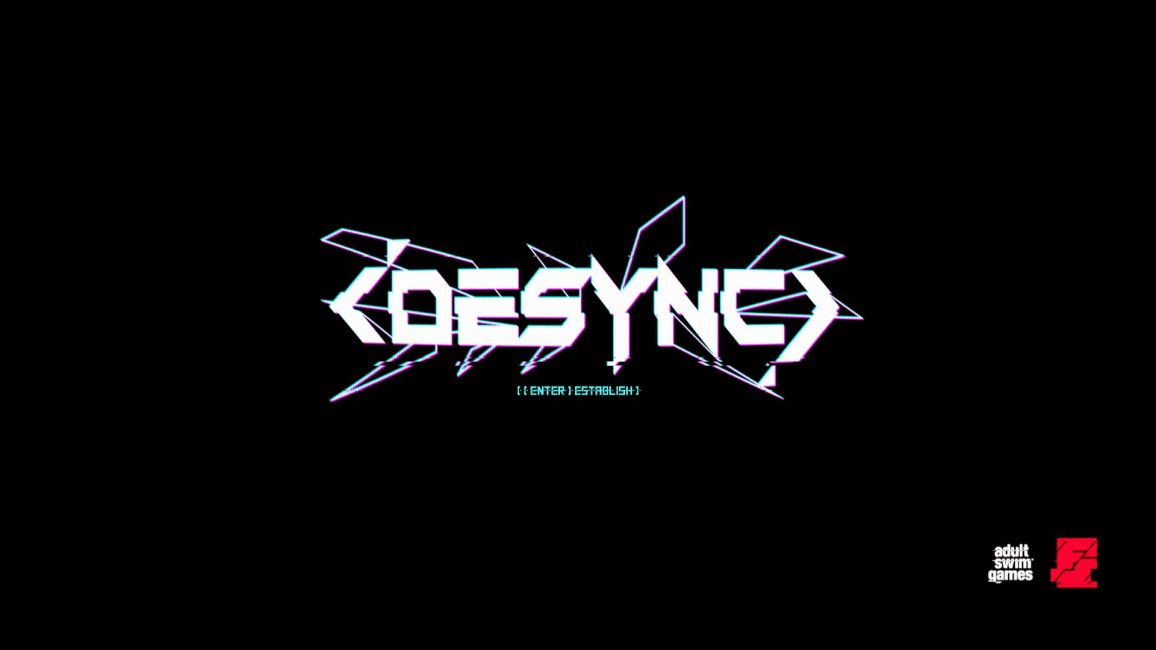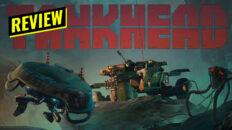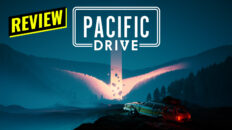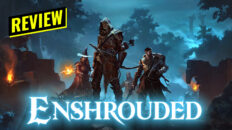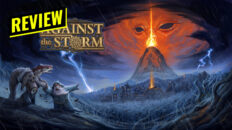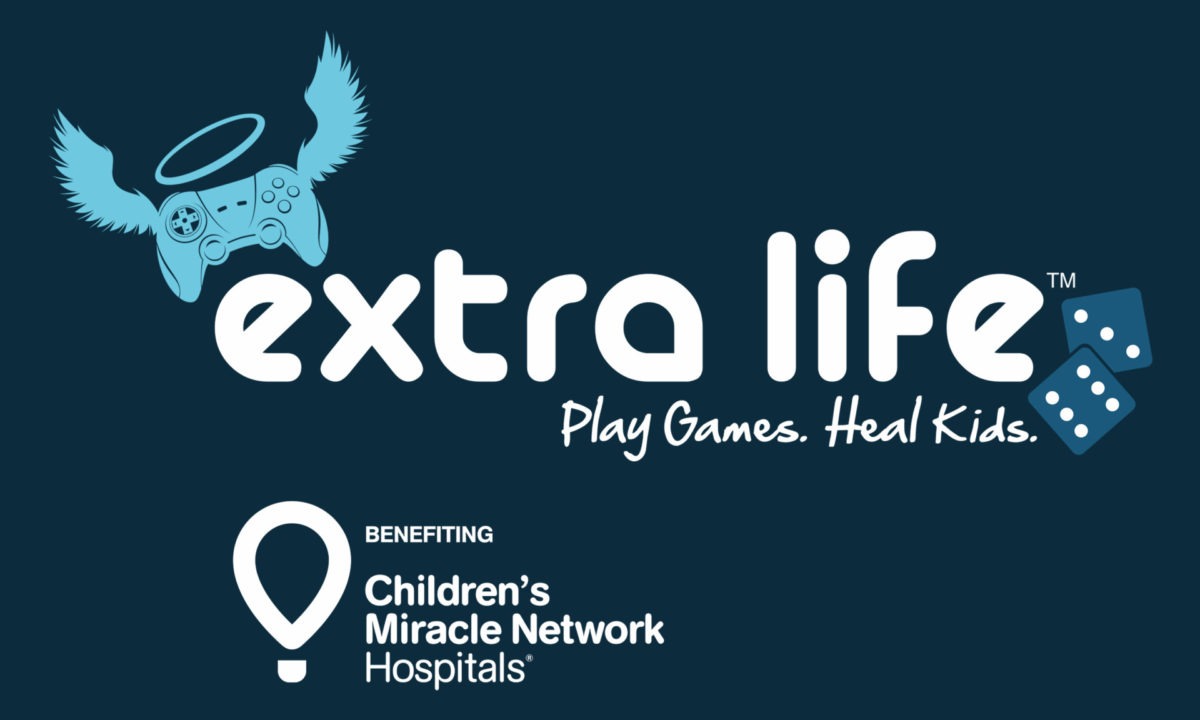Developer: The Foregone Syndicate
Publisher: Adult Swim Games
Reviewed on: PC
Code Received
What do you get if you mix one part Painkiller, one part Bulletstorm, one part Quake, and then slather it all in a thick layer of Tron? Well, apparently you get DESYNC.
Forgone Syndicate’s DESYNC is a fast paced, mad-as-hell shooter, that throws wave after wave of brutal enemies at you. In this digital world it’s kill or be killed, and it’s a whole lot better to be the one that’s doing the killing. Take away the frantic twitchy gameplay, the pretty visuals, and all that’s left is pure brutality. And it can be excessively brutal.
Gameplay
DESYNC is at the same time both satisfying and frustrating. Sounds like an oxymoron, I know, but that is exactly how it feels. Harkening back to the older, tougher days of gaming, the game thrusts you helplessly into its neon world. Moments after the first level begins, wave after wave of enemies strike, hellbent on getting the kill. There’s little in the way of explanation in DESYNC, and almost everything from basic the game’s mechanics, to core features are left to discovery, sometimes through trial-and-error.
Success in DESYNC requires constant movement, aided by the ability to zip around your enemies with the Shift key. There’s no sprinting in the game, instead it’s replaced by a quick, short dash. Used right, the ability can let you dance circles around your enemies, and the quick sudden flow feels almost natural to the game’s thumping, quick rhythm. As intuitive and satisfying as dashing is, jumping is quite the opposite. A decent, high jump would feel right at home in a game that requires creative, crafty kills to rack up the bigger points. Unfortunately, you end up with a dissatisfying hop that moves you but a fraction off the ground. High-flying action this game has not.
Simply zipping around your enemies won’t get you very far though. DESYNC prides itself as a skill-based shooter, and the weapon variety truly shows it. From the fast firing pistol to the devastating energy-orb launcher, the game certainly offers a lot of ways to decimate your enemies. Each type of weapon comes with two types of fire, adding variety to your kills. The shotgun, for example, is capable of also launching a stationary spinning shuriken of pure energy. Weapons do have limited ammo however, and while your starter pistol is able to recharge, other weapons rely on ammo. There are no ammo pick-ups either, instead enemies will drop both health and ammo when struck down with an Attack Sequence.

Each time you manage to get one of the special kills programmed into the game, everything slows down to focus on just what you’ve done. The name of the Attack Sequence flashes on the screen, listing exactly what was done to achieve it. The experience is actually rather rewarding, especially when something you think will get you a Sequence actually does. Attack Sequences are the bread-and-butter to get high scores on each of the game’s levels, with the more creative kills netting higher points obviously. There’s a multitude of ways to grab these Sequences, from switching weapons to taking advantage of enemy weaknesses to using the various environmental hazards scattered around the level.
DESYNC also lets you customize your weapons and skills to preferred play styles. Scattered across levels are schematics for Cores, each when equipped allows access to different abilities, like single-use health kits or temporary damage buffs. Side-arms are another factor into grabbing Sequences and altering how the game plays. Get enough points to fill the Side-arm bar and the item appears in the level, letting you grab an additional weapon or a shield. Also scattered across each level are Shards, currency that let you build and buy augmentations for each weapon. No benefit is without drawback however, as each buff also nets you a negative debuff. Want higher damage potential? Well you’ll have to deal with a slower rate of fire to get that.
The levels of DESYNC are where the game feels most like Quake. Though smaller and narrower, an in-depth knowledge of each level’s layout can give you a massive advantage. It’s also helpful that enemy spawn points are set, and once memorized can also give you an advantage. While there is no multiplayer, the game does feature an online leaderboard, comparing the scores from the best to the not-so-good players. Everything factors into play when calculating your score, and the end level screen gives you an idea of just how good… or bad you did.
For those looking for even greater challenges, the game offers Dark Zones. These altered levels disregard any custom weapons and gear, setting you up with a unique loadout instead. The difficulty is only heightened by the addition of Mutators, factors that change how the game plays. Mutators change the level in a variety of ways, both beneficial and harmful. You can get lucky and have a Mutator that lets you move faster, or the game can decide that enemies take only get damage while airborne. If regular DESYNC is hard, Dark Zones push everything beyond 11.
With all that it has going for it, DESYNC is not without flaws. The game is hard, undoubtedly so, and while this is actually a feature, there are times where the game just feels unfair. Enemies sometimes change trajectories in mid-air, landing on top of you even after a successful dodge. It doesn’t help that majority of the enemies in the game use melee weapons, leaving those with ranged attacks few and far between. It’s a strange disconnect, and while it does offer an advantage, there are times when it can get overwhelming. This could be understandable if the game didn’t choose to keep almost all of it’s mechanics a secret . For example, when selecting a level, while the game offers a prompt to access this selection, you’re not exactly told what button to press to actually access the level selection (It’s right-click, by the way).

Don’t think you’ll be able to get an A on the very first go on a level. No, that rank requires you to return with better weapons to push your score higher. Though it does add replayability, it’d be nice to have a way to get a high enough score with just the standard gear. Certain Synced foes you face can also be Desynced. This is another mechanic the game doesn’t really explain well, leaving the player to mess around to figure out exactly how it works. With a mechanic as important as this, it’s strange that there’s no clear, even brief, explanation given to its exact workings.
Bosses, or Zone Defenders, are another factor. Like the game, the bosses are hard and in a Dark Souls fashion, it’ll often take multiple attempts to bring one down. While they can get frustrating, hammering at you with powerful attacks and abilities, defeating a boss is rather satisfying. Also, in old-school fashion, if you die fighting a boss, you’re going to have to start all over again. The difficulty is only enhanced by bosses having stages, in fact the first boss requires being killed twice. So be prepared.
Graphics & Sound
DESYNC’s visual aesthetic is its strongest feature, but it is also one if the game’s defining flaws. Visually stunning with a Tron-like 80s vibe, the game is beautiful to look at. Sleek lines, neon lights, and angular designs make the game a treat for the eyes. It’s quite a treat actually, until you notice the layer of distortions and occasional blurring that the developers have chosen to add onto the game. While fitting the theme well, this glitching and blurring only distracts from the game instead of adding to it. It’s most blatantly shown during the game’s menus, and might even result in a headache. Or a complete disconnect. At one point I wasn’t certain if something was wrong with my eyes, monitor, or the game itself. These effects are something the game’s style could definitely have done without.

Sound however is easily the most perfect thing about the game. Featuring a thumping, retro-synth soundtrack by Daniel Deluxe and Volkor X, the music rises and thrums with the game, augmenting each dodge, each kill, and each death. It isn’t hard to find yourself flowing with the music, even with the intense focus the game demands. It’s great when a game’s visuals and sounds meet in harmony and DESYNC definitely achieves that.
Performance
There’s hardly any noticeable change in the game’s performance, even during its most intense moments. DESYNC continues to offer a smooth, steady experience that it’s visuals require and what most anyone would desire. My own play through of the game didn’t bring up any performance issues at all. While lower-specs could probably have some issues, the game runs great on mid-tier to higher end machines.
Conclusion
DESYNC is an intense, nail-biting experience that rewards risk-taking and skill. For fans of of a more bygone era when games were harder, DESYNC will be a welcome addition. In fact, anyone looking for a challenging first-person game that demands quick-thinking and skills, this is a game that I definitely recommend. It is, however, not a game for everyone. If you’re easily frustrated, or not used to games that require intense focus and situational awareness, then you won’t have much fun. Still, there’s a unique experience to be had in DESYNC, despite its flaws (and lack of a multiplayer for those that prefer such a thing), and at only $14.99, it’s a game worth checking out if you’re even the slightest bit intrigued.
[full_width]PC Specs:
Windows 10 Pro 64-bit
Intel Core i7-6700HQ 2.60GHz
16GB RAM
GeForce GTX 960M 2GB[/full_width]


